 I am ashamed to announce that I still haven't finished the Quantity Theory of Insanity, because I keep reading other things in between. Last night I tried again, and came upon the following passage on page 130 in my Penguin edition:"Sid was now living in a small commune in the Shetland Islands, where he and his fellow communards were dedicated to the growing of implausibly large hydroponic onions. The other members of the commune were eccentric but not quite as unhinged as Sid. They believed that their ability to grow the four-foot legumes was wholly predicated on the orbital cycle of Saturn's satellite, Ceres."This bothers me immensely; onions are not legumes. Onions are monocots for a start (in the family Liliaceae or in their own family Alliaceae, depending on who you talk to). Legumes are things like beans, peas etc. in the family Fabaceae, along with acacias and the like, and are obviously dicots. This has now completely ruined the whole thing for me. Surely these two kinds of vegetables are the exact examples used to explain this difference in school? And all of this for want of a funky synonym for 'onion'...
I am ashamed to announce that I still haven't finished the Quantity Theory of Insanity, because I keep reading other things in between. Last night I tried again, and came upon the following passage on page 130 in my Penguin edition:"Sid was now living in a small commune in the Shetland Islands, where he and his fellow communards were dedicated to the growing of implausibly large hydroponic onions. The other members of the commune were eccentric but not quite as unhinged as Sid. They believed that their ability to grow the four-foot legumes was wholly predicated on the orbital cycle of Saturn's satellite, Ceres."This bothers me immensely; onions are not legumes. Onions are monocots for a start (in the family Liliaceae or in their own family Alliaceae, depending on who you talk to). Legumes are things like beans, peas etc. in the family Fabaceae, along with acacias and the like, and are obviously dicots. This has now completely ruined the whole thing for me. Surely these two kinds of vegetables are the exact examples used to explain this difference in school? And all of this for want of a funky synonym for 'onion'...
This has been a marginally remarkable weekend. I spent almost all of Friday at the Exclusive Books in the duty-free mall at Johannesburg International Airport, helping out behind the counter while the regular staff have some version of a Christmas Party. Initially, I was quite concerned about the procedures, but got the hang of it in the end. It's quite something to touch a business class boarding pass for a Cathay Pacific flight to somewhere exotic. It's also quite something when a customer wants to buy a newspaper with a $100 bill and you have to give them change in Rands... Denise and I helped the head steward of Tanzania Air carry bags of magazines to his plane, which was interesting: we could look directly out from the ramp at the rainy runways and the shiny new Qantas 747-400. Denise is airplane-crazy and a great source of information at the airport. She's hinted several times that she'd love to work there. I'm not so sure that I enjoy the throngs of people bringing their diseases from all corners of the globe.Afterwards, Wendy, Denise and I drove to Bryanston by mistake to drop by Rowan's new place for tortillas and Karen's famous chilli. I am not implying that Rowan and Karen aren't excellent hosts, but the fact is that it took us hours to get there from Kempton. I'll never understand traffic jams in the middle of the night without any visible accidents or roadworks. Surely all those people can't be going to Montecasino? If that's the case, gambling is much more prevalent than I suspected. (The chilli was delicious, by the way.)Today I've been spending my hours sifting through the University library's collection of electronic journals, looking for new articles published on plant disease resistance and gene expression profiling. I've now given up on the idea of finishing any labwork by the end of this year (you need accurate pipettes for that) and decided to source some holiday reading. I was actually having a good time, my mind awash with signalling pathways, cysteine proteases, kinases and PR proteins. But as I was walking to the lab from the computer room in order to get more paper for the printer, I noticed that the -80°C freezer had gone up to -45°C. I was then informed that the freezer had been on the carbon dioxide back-up since early this morning and that we'd have to move all of the samples boxes to other freezers! My first (admittedly selfish) thought was of my precious RNA, which I immediately archived in an open spot in the -80°C freezer in Lab X (yes, that's really what it's called). We then spent about a century putting sample boxes in random spots in the freezers of other research groups; I don't think we will ever see those boxes again now that they're spread across the whole faculty. Should I care? The people those boxes belong to aren't even here this month and equipment always breaks down in December. I suppose that it's serendipity that I managed to salvage my Precious today, as I was not planning on coming in to the lab again this week. That box with 20 tubes of RNA is the first thing I'd save from the building in the event of disaster. Strange how discriminate your priorities become when you've spent so much time on little vials of biological material you can't even see.
This November we have finally had some rain, which all the plants appreciate. Nothing is more pleasurable than the sight of green root tips exploring the growing medium around an orchid with swollen pseudobulbs. If I can just prevent the snails from snacking on these tropical delicacies, that would be even better... Den. Aquatum Halawa. A delightful miniature hardcane Dendrobium with bigibbum- and antelope-type species in its ancestry.
Den. Aquatum Halawa. A delightful miniature hardcane Dendrobium with bigibbum- and antelope-type species in its ancestry.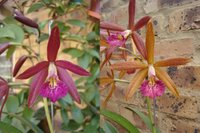 Blc. Rustic Spots. A very interesting Brassolaeliocattleya, because the flowers change colour as they mature. The photograph on the left was taken the day the flower opened, a rich, dark brown colour. The photograph on the right is of the same flower, taken a week later, the flower being a copper colour with more prominent spotting. I love the spots on the labellum, which resemble bits of embedded metal.
Blc. Rustic Spots. A very interesting Brassolaeliocattleya, because the flowers change colour as they mature. The photograph on the left was taken the day the flower opened, a rich, dark brown colour. The photograph on the right is of the same flower, taken a week later, the flower being a copper colour with more prominent spotting. I love the spots on the labellum, which resemble bits of embedded metal.
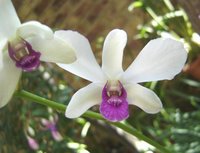 Den. Burana Charming. A hardcane I adopted from a friend. Seems that white flowers with purple lips are much the thing for November.
Den. Burana Charming. A hardcane I adopted from a friend. Seems that white flowers with purple lips are much the thing for November.
 Epc. El Hatillo. A yummy hybrid with Encyclia tampensis in its parentage. This is the most prolific flowering I've had since I purchased it about three years ago - bright light is the key. According to its label it is actually a back-cross with an alba variety of Enc. tampensis (without the purple labellum), but it looks pretty much like a normal El Hatillo to me.
Epc. El Hatillo. A yummy hybrid with Encyclia tampensis in its parentage. This is the most prolific flowering I've had since I purchased it about three years ago - bright light is the key. According to its label it is actually a back-cross with an alba variety of Enc. tampensis (without the purple labellum), but it looks pretty much like a normal El Hatillo to me.
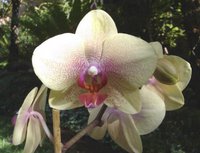 Phal. (Jane Doe). This tagless Phalaenopsis hybrid has interesting colour combinations.
Phal. (Jane Doe). This tagless Phalaenopsis hybrid has interesting colour combinations.
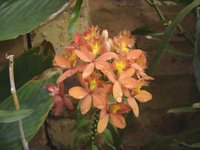 Epi. Orange Glow. The largest reedstem Epidendrum in my collection. The flowers are enormous (for an epi!) and have a wonderful iridescence.
Epi. Orange Glow. The largest reedstem Epidendrum in my collection. The flowers are enormous (for an epi!) and have a wonderful iridescence.
 Phrag. Sedenii. Yes, it has finally flowered! Lots of new buds are on their way, as well as another flower spike. This is a very beautiful and exciting plant: it just makes me want to collect some more Phragmipediums. Take a look at Phrag. Flash Gordan and Phrag. Jimi Hendrix at www.phragweb.info! As Jenny Holzer said: "Protect me from what I want", because if this doesn't cause orchid fever, nothing will!
Phrag. Sedenii. Yes, it has finally flowered! Lots of new buds are on their way, as well as another flower spike. This is a very beautiful and exciting plant: it just makes me want to collect some more Phragmipediums. Take a look at Phrag. Flash Gordan and Phrag. Jimi Hendrix at www.phragweb.info! As Jenny Holzer said: "Protect me from what I want", because if this doesn't cause orchid fever, nothing will!
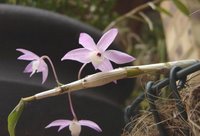 Den. hercoglossum. The teeny-tiny flowers have dark anther caps. It grows under shade net in a hanging basket suspended beneath the staging next to the house (could I be any more specific?).
Den. hercoglossum. The teeny-tiny flowers have dark anther caps. It grows under shade net in a hanging basket suspended beneath the staging next to the house (could I be any more specific?).
 Vasco. (Ascda. Tubtim Velvet 4N x Vasco. Five Friendship). A new acquisition. This Vascostylis is compact (necessary if you consider the size of my greenhouse), yet retains the impact (could be the polyploidy in its lineage). Full shape.
Vasco. (Ascda. Tubtim Velvet 4N x Vasco. Five Friendship). A new acquisition. This Vascostylis is compact (necessary if you consider the size of my greenhouse), yet retains the impact (could be the polyploidy in its lineage). Full shape.
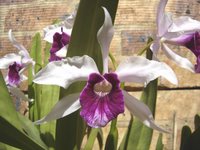 Laelia purpurata (Treasure of Carpinterio AM/AOS x Pink Dawn HCC/AOS). A cross between two awarded var. schusteriana selections. Yummy! This monster produced 15 flowers on four spikes and is the single most auspicious flowering event since I accidentally read The Orchid Thief by Susan Orlean in 2001 and started on this insane journey! The flowers were between 15cm and 20cm in diameter and emitted a delightfully sophisticated fragrance. Yummy, I say!
Laelia purpurata (Treasure of Carpinterio AM/AOS x Pink Dawn HCC/AOS). A cross between two awarded var. schusteriana selections. Yummy! This monster produced 15 flowers on four spikes and is the single most auspicious flowering event since I accidentally read The Orchid Thief by Susan Orlean in 2001 and started on this insane journey! The flowers were between 15cm and 20cm in diameter and emitted a delightfully sophisticated fragrance. Yummy, I say!
 I am ashamed to announce that I still haven't finished the Quantity Theory of Insanity, because I keep reading other things in between. Last night I tried again, and came upon the following passage on page 130 in my Penguin edition:
I am ashamed to announce that I still haven't finished the Quantity Theory of Insanity, because I keep reading other things in between. Last night I tried again, and came upon the following passage on page 130 in my Penguin edition:









